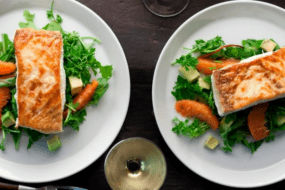
In today’s fast-paced world, where convenience often outweighs nutrition, the concept of “superfoods” has gained traction for good reason. These nutrient-dense foods aren’t just trends—they’re scientifically backed powerhouses that can help prevent disease, boost immunity, and promote overall vitality. Whether you’re looking to supercharge your energy, balance your hormones, or protect your heart, incorporating superfoods into your daily diet is a delicious and natural way to invest in your health.
In this guide, we’re unveiling some of the most potent superfoods, explaining what makes them “super,” and how to make them part of your everyday meals. Get ready to nourish your body from the inside out.
What Are Superfoods, Really?
“Superfood” is a term used to describe foods that are exceptionally rich in nutrients like vitamins, minerals, antioxidants, and phytochemicals. While it’s not a medical classification, the term highlights the incredible health benefits certain natural foods offer.
Superfoods often:
- Contain high levels of antioxidants
- Are rich in fiber, healthy fats, or plant-based protein
- Possess anti-inflammatory properties
- Support specific body functions like digestion, immunity, and cognition
Let’s explore the top categories of superfoods and their stars.
1. Leafy Greens: Nature’s Multivitamin
Dark leafy greens are some of the most nutrient-packed foods on the planet. They’re low in calories but bursting with vitamins A, C, K, folate, iron, calcium, and fiber.
Top Picks:
- Kale – Loaded with antioxidants and vitamin K, kale supports heart health and bone strength.
- Spinach – Rich in iron and magnesium, it boosts energy and supports muscle function.
- Swiss Chard – Contains betalains, which have antioxidant and detoxifying effects.
How to Enjoy:
Add them to smoothies, sauté with garlic, or mix into soups and omelets.
2. Berries: Antioxidant Powerhouses
Berries are rich in anthocyanins, vitamin C, and fiber. They help reduce inflammation, improve brain health, and protect against heart disease.
Top Picks:
- Blueberries – Known for brain-boosting benefits and lowering blood pressure.
- Strawberries – High in vitamin C and polyphenols that support skin health.
- Goji Berries – Used in traditional Chinese medicine for immune support and vision.
How to Enjoy:
Toss into oatmeal, blend into smoothies, or enjoy fresh as a snack.
3. Seeds: Small but Mighty
Despite their size, seeds pack a powerful nutritional punch. They’re full of fiber, protein, omega-3 fatty acids, and essential minerals.
Top Picks:
- Chia Seeds – Excellent source of omega-3s and fiber; they expand in liquid to create a satisfying texture.
- Flaxseeds – Rich in lignans (plant compounds with antioxidant properties) and great for digestive health.
- Pumpkin Seeds – High in magnesium, which supports heart and muscle function.
How to Enjoy:
Sprinkle on yogurt, mix into baked goods, or blend into smoothies.
4. Fatty Fish: Omega-3 Goldmine
Fatty fish are among the best sources of omega-3 fatty acids, which are essential for brain function, reducing inflammation, and supporting heart health.
Top Picks:
- Salmon – Rich in DHA and EPA, the most bioavailable forms of omega-3s.
- Sardines – Contain calcium, vitamin D, and omega-3s in a small package.
- Mackerel – High in protein, B vitamins, and healthy fats.
How to Enjoy:
Grill, bake, or pan-sear with herbs and lemon. Choose wild-caught varieties for the highest quality.
5. Whole Grains: Fuel for Your Body
Whole grains provide slow-digesting carbohydrates, fiber, B vitamins, and minerals like magnesium and zinc.
Top Picks:
- Quinoa – A complete protein that’s also rich in iron and magnesium.
- Oats – Excellent for heart health, thanks to beta-glucan, a fiber that helps reduce cholesterol.
- Brown Rice – Provides sustained energy and essential nutrients.
How to Enjoy:
Use as a base for bowls, mix into salads, or enjoy as a hearty breakfast.
6. Fermented Foods: Gut Health Heroes
Your gut is home to trillions of bacteria that influence everything from digestion to immunity to mood. Fermented foods are full of probiotics—live bacteria that benefit your microbiome.
Top Picks:
- Sauerkraut – Fermented cabbage packed with vitamin C and beneficial bacteria.
- Kimchi – Spicy and flavorful, it supports digestion and immune function.
- Kefir – A drinkable yogurt alternative rich in probiotics and protein.
How to Enjoy:
Add kimchi to rice bowls, enjoy kefir as a drink, or top your salads with sauerkraut.
7. Nuts: Nature’s Healthy Fat Source
Nuts are rich in heart-healthy fats, protein, and fiber. They help manage cholesterol, stabilize blood sugar, and keep you feeling full longer.
Top Picks:
- Almonds – High in vitamin E and magnesium.
- Walnuts – A good source of plant-based omega-3s.
- Brazil Nuts – Exceptionally high in selenium, which supports thyroid function.
How to Enjoy:
Eat raw as a snack, blend into nut butters, or use as crunchy toppings.
8. Cruciferous Vegetables: Detox and Disease Defense
This family of veggies contains glucosinolates, which have cancer-fighting and detoxifying properties.
Top Picks:
- Broccoli – Rich in sulforaphane, a compound that may reduce inflammation and oxidative stress.
- Cauliflower – High in fiber and versatile for low-carb recipes.
- Brussels Sprouts – Loaded with vitamin C and K, great for immunity and bone health.
How to Enjoy:
Roast with olive oil, steam for a side dish, or blend into soups.
9. Legumes: Plant-Based Protein and Fiber
Beans, lentils, and peas are rich in fiber, protein, and complex carbs. They support heart health, stabilize blood sugar, and promote satiety.
Top Picks:
- Lentils – High in folate, iron, and protein.
- Chickpeas – Versatile and rich in fiber and manganese.
- Black Beans – Great source of plant protein and antioxidants.
How to Enjoy:
Use in stews, blend into dips like hummus, or add to salads and bowls.
10. Superfood Spices: Small Dose, Big Impact
Spices do more than flavor your food—they have powerful medicinal properties.
Top Picks:
- Turmeric – Contains curcumin, an anti-inflammatory compound.
- Ginger – Helps with digestion, nausea, and inflammation.
- Cinnamon – Supports blood sugar balance and is packed with antioxidants.
How to Enjoy:
Add to smoothies, golden milk, or sprinkle into oatmeal and baked goods.
Honorable Mentions
These foods may not fit neatly into a category but deserve a place on your plate:
- Avocados – High in healthy fats, potassium, and fiber.
- Matcha – Concentrated green tea packed with antioxidants and L-theanine, which promotes calm focus.
- Seaweed – A rich source of iodine, great for thyroid function.
Tips for Incorporating Superfoods into Your Life
Adding superfoods to your routine doesn’t mean overhauling your entire diet overnight. Here’s how to make it sustainable and enjoyable:
1. Start Small
Choose one or two new superfoods per week and find easy ways to incorporate them into meals you already enjoy.
2. Balance Is Key
Superfoods are powerful, but they work best in synergy with a balanced diet—fruits, veggies, whole grains, lean proteins, and healthy fats.
3. Go Seasonal and Local
Fresh, seasonal produce often retains more nutrients and supports local agriculture.
4. Mind the Portions
Even nutrient-dense foods can lead to excess calories. Pay attention to portion sizes, especially for calorie-dense foods like nuts and seeds.
The Superfood Lifestyle: It’s More Than What You Eat
Optimal wellness is a holistic endeavor. While superfoods play a critical role, your overall lifestyle matters just as much. To truly unlock their benefits, pair a superfood-rich diet with:
- Hydration – Drink plenty of water throughout the day.
- Movement – Exercise regularly to improve circulation and support digestion.
- Rest – Prioritize quality sleep to allow your body to repair and restore.
- Mindfulness – Stress impacts digestion and inflammation; practices like meditation or deep breathing can help.
Conclusion: Eat to Thrive, Not Just Survive
Superfoods aren’t a magic bullet, but they are powerful tools in your wellness toolkit. By weaving a variety of them into your meals, you’re not just feeding your body—you’re nurturing a foundation of long-term vitality. The key is diversity, consistency, and enjoyment.
So whether it’s sprinkling chia seeds into your breakfast, swapping in lentils for meat once a week, or sipping a soothing matcha latte, every small choice adds up. Eat with intention, nourish with joy, and let food be your daily medicine.
Would you like this turned into a blog post format, social media carousel, or even a downloadable PDF? I can help format or expand it however you’d like!






















